|
Family: Otididae (bustards and
korhaans)
Life
> Eukaryotes >
Opisthokonta
> Metazoa (animals) >
Bilateria >
Deuterostomia > Chordata >
Craniata > Vertebrata (vertebrates) > Gnathostomata (jawed
vertebrates) > Teleostomi (teleost fish) > Osteichthyes (bony fish) > Class:
Sarcopterygii (lobe-finned
fish) > Stegocephalia (terrestrial
vertebrates) > Tetrapoda
(four-legged vertebrates) > Reptiliomorpha > Amniota >
Reptilia (reptiles) >
Romeriida > Diapsida > Archosauromorpha > Archosauria >
Dinosauria
(dinosaurs) > Saurischia > Theropoda (bipedal predatory dinosaurs) >
Coelurosauria > Maniraptora > Aves
(birds) > Order: Gruiformes
Species indigenous to southern Africa
|
Afrotis
afra (Southern black korhaan) The Southern black korhaan is endemic to South Africa,
being found in the Western, Eastern and Northern Capes. It is common to uncommon
in the remnants of renosterveld and strandveld in the Western Cape, and nama
karoo in the Northern Cape. It feeds on insects, small reptiles and plant
material, foraging on the ground and picking up food items with its bill. It
is polygynous, meaning that the male mates with multiple females, who do all
the incubation and caring of the chicks. Its 1-2 are laid eggs directly on
the ground, often so that it conceals the incubating female. |
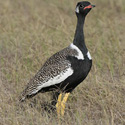 |
|
Afrotis
afraoides (Northern black korhaan, White-quilled korhaan)
The Northern black korhaan is endemic to southern Africa, and is uncommon to
common in a wide variety of habitats. It feeds mainly on insects, such as
termites, grasshoppers and beetles, but it also eats plant products, such as
seeds. The male vigorously defends his displaying territory from other
males, attacking them with his wings and mating with multiple females, who
solely incubates the 1-3 eggs and raises the chicks. Amazingly, the chicks
can fly when they are only half grown! |
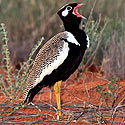 |
|
Ardeotis
kori (Kori bustard) The Kori bustard
has two subspecies, with one occurring in north-eastern Africa, while the
other mainly occurs in southern Africa, living in a wide variety of mainly
dry habitats. It eats a wide variety of animals and plant products, often
eating hard materials, such as stones, pieces of bones and even bullet
shells and broken glass! The male does a courtship display to multiple
females, after which it mates with some of them, all incubating and
parenting are left to be done by the female. The 1-2 chicks are able to fly
when they are 3-4 months old, but they remain dependent on their mother
until the following breeding season, when they are 12-18 months old. |
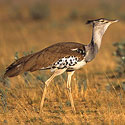 |
|
Eupodotis
caerulescens (Blue korhaan) |
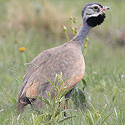 |
|
Eupodotis
rueppellii (Rüppell's korhaan) |
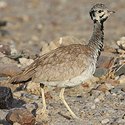 |
|
Eupodotis
senegalensis (White-bellied korhaan) |
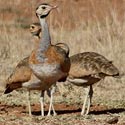 |
|
Eupodotis
vigorsii (Karoo korhaan) |
 |
|
Lissotis
melanogaster (Black-bellied bustard, Black-bellied korhaan) The
Black-bellied bustard occurs from Senegal east to Ethiopia, extending south
to southern Africa, where it is uncommon to locally common in a wide variety
of mainly grassy habitats. Its diet is little known in southern Africa, but
elsewhere it is omnivorous, mainly feeding feeding on small invertebrates,
such as locusts, grasshoppers and beetles, as well as vegetable matter, such
as fruit, seeds and leaves. The male does an elaborate courtship display to
multiple females, whom he mates with afterwards. The incubating and
parenting is done solely by the female, who protects intruders who get to
close to the "nest", which is a bare scrape in the ground, with wings
outstretched. |
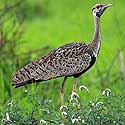 |
|
Lophotis
ruficrista (Red-crested korhaan) The Red-crested korhaan
is near-endemic to southern Africa, being uncommon to locally common in a
range of woodland habitats. It is omnivorous, feeding on invertebrates,
especially termites, beetles and grasshoppers, and plant matter, especially
seeds and fruit, foraging on the ground, picking up food items with its
bill. The male puts on a spectacular courtship display to multiple females,
who solely incubate the eggs and raise the chicks. It lays 1-2 eggs, which
are incubated solely by the female, for about 22 days, and little is known
about the chicks. |
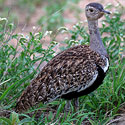 |
|
Neotis
denhami (Denham's bustard, Stanley's bustard) The Denham's bustard is widespread in the Afrotropics,
from western to southern Africa, where it is scarce to locally common in
grassland, fynbos and cultivated areas. It is omnivorous, feeding on a wide
range of animals, including grasshoppers, weevils, spiders, and even snakes,
as well as plant products, including grass, leaves and flowers. It is
polygynous, the male mating with multiple females, who will take on all the
incubation and chick rearing duties. It lays 1-2 eggs, which hatch after
about 23-25 days. The chicks are cared for by their mother, who will catch
food and put into in front of the chicks, although later they start foraging
for themselves. |
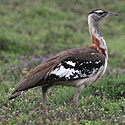 |
|
Neotis
ludwigii (Ludwig's bustard) |
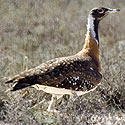 |
|
